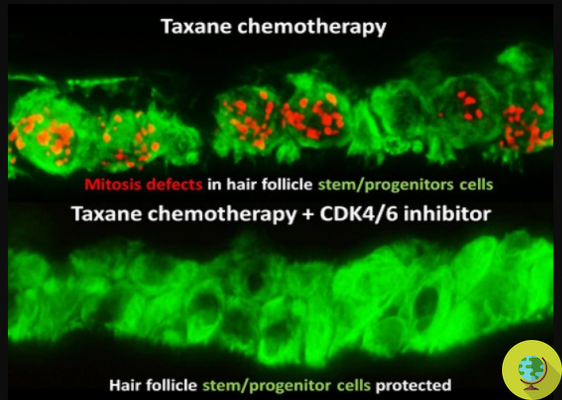From a British study comes the way to counteract post-chemotherapy hair loss by preventing damage to the hair follicle caused by taxanes.
Don't store avocado like this: it's dangerousChemotherapy without hair loss? It could be possible thanks to the discovery of some British scientists, who have developed a new method that could potentially prevent the disastrous hair loss induced by chemo, with the use of an ex vivo organ culture model.
The loss of one's hair is in fact considered one of the most psychologically distressing symptoms of therapies following cancer, to the point that treatment may be refused to avoid it.
Now, the University of Manchester scholars have started with the analysis of "taxanes", a class of chemotherapy agents commonly used to treat breast cancer and in this research they have specifically determined how the taxanes cause damage to the hair follicle and, therefore, how to prevent such damage and the psychological stress it induces.
How do taxanes cause hair loss?
Taxanes work by preventing cancer cells from passing through mitosis. Hair loss can occur due to their use because they also prevent mitosis in normally dividing cells.

“A key part of our study was to understand how exactly hair follicles responded to taxane chemotherapy and we discovered and discovered that the specialized dividing cells at the base of the hair follicle that are critical for hair production, and the stem cells from which they derive are the most vulnerable to taxanes, ”explains Talveen Purba, coordinator of the study.
Based on this and understanding the mechanism behind taxane-induced hair loss, the researchers sought a way to prevent damage to the hair follicle without compromising the taxane's effects on cancer cells. The answer came in the form of CDK4 / 6 inhibitors, another type of chemotherapy considered useful to exert its effects in a more targeted way.
“We found that CDK4 / 6 inhibitors can be temporarily used to stop cell division without promoting further toxic effects in the hair follicle. When we bathed organ-grown hair follicles in the scalp with CDK4 / 6 inhibitors, the hair follicles were much less sensitive to the damaging effects of taxanes, ”Purba says.
However, the authors acknowledge that further investigation will be needed before their findings can be applied clinically, suggesting a shift from an ex vivo model to the use of xenografted human scalp hair follicles.
"We need time to further develop approaches like this to not only prevent hair loss, but to promote hair follicle regeneration in patients who have already lost their hair due to chemotherapy," they conclude.
Read also:
- Hair: discovered the mechanism that regulates its life cycle and vitality
- Chemotherapy: the hair loss cap arrives
Germana Carillo


























